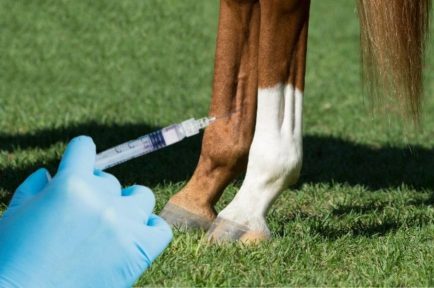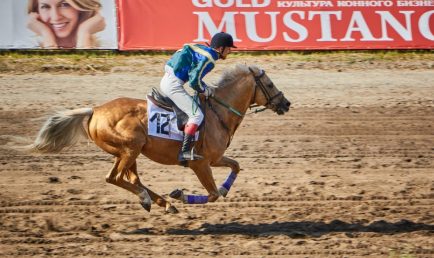If your horse has joint problems, your veterinarian might suggest that glucosamine for horses injection would be beneficial. But what are the advantages of an injection over a feed supplement when it comes to glucosamine in horses? Would glucosamine for horses injection help your horse? Let’s find out!
If your horse has joint problems, your veterinarian might suggest that glucosamine for horses injection would be beneficial. But what are the advantages of an injection over a feed supplement when it comes to glucosamine in horses? Would glucosamine for horses injection help your horse? Let’s find out!
The types of glucosamine found in equine joint treatments can come from one of two sources. It can either be manufactured in a laboratory, which is known as synthetic glucosamine. Alternatively, it can come from natural sources such as shellfish.
Why Is Glucosamine Given To Horses?
When a horse suffers damage to the cartilage of the joints, glucosamine is often recommended as the first line of treatment. Joint problems such as osteoarthritis are very common in horses and can cause a significant amount of pain, inflammation, and cartilage breakdown in the joint.
If given correctly, glucosamine can be utilized by the horse to prevent cartilage breakdown and promote healing of the damaged joint tissues. This helps to ease inflammation within the joint, improving overall comfort and mobility.
What Is A Glucosamine Injection For Horses?
Most horse owners will be familiar with glucosamine which is given as part of an oral joint supplement for horses. Feed supplements have been the first-line treatment for horses with joint problems for many years, used successfully to keep horses comfortable and in work through their later years.
But what is a glucosamine injection for horses, and how effective is it? The glucosamine injection for horses is a veterinary prescription-only medication, which means it is only available from your veterinary clinic. Before your veterinarian prescribes this medication, it may be necessary to carry out extensive diagnostic tests to obtain a conclusive diagnosis.
This medication is normally given by intramuscular injection, meaning it goes directly into the muscle of the horse. The amount and frequency of the injections will be decided by your veterinarian.
What Other Injections Are Used For Horses With Joint Problems?
As well as glucosamine injections, some other prescription-only medicines may be advised by your veterinarian:
· Hyaluronic Acid (HA)
Hyaluronic Acid (HA) is a medication licensed for intramuscular injection in horses, although some veterinarians may also use it as a joint medication. HA is used to lubricate the cartilage within the joint, easing discomfort and helping damaged tissues to repair.
· Polysulfated Glycosaminoglycans
Polysulfated Glycosaminoglycans (PSGAGs) are also licensed for intramuscular injection in the horse, although again some veterinarians may also use them as joint medication. PSGAGs are the building blocks for cartilage repair, and this product is normally used when cartilage damage is already present. The most common form of PSGAG is Adequan.
· Corticosteroids
The use of corticosteroids to treat joint problems in horses is somewhat controversial, as in some cases it is thought to make the problem worse. However, when used correctly these drugs can rapidly ease inflammation, reducing the presence of destructive enzymes and helping the tissue to repair faster and more efficiently.
· Non-Steroidal Anti-Inflammatory Drugs
Many horses with joint problems also require a long-term course of non-steroidal anti-inflammatory drugs (NSAIDs). These are often given at a higher dose initially, then a lower maintenance dose is continued once the pain and inflammation ease.
Most NSAIDs are available in both injectable and oral forms, meaning they are convenient for the horse owner to give at home once the initial pain has started to ease.
One of the most popular NSAIDs for horses is phenylbutazone or bute. This must never be fed to horses intended to enter the human food chain, as it is highly toxic to humans. Phenylbutazone can also have toxic effects if given in large amounts for a long period of time.
Summary
So, as we have learned, glucosamine for horses injection is administered into the muscle of the horse, to provide long-lasting relief from degenerative joint conditions. Other medications used to ease the pain and inflammation of joint problems and aid tissue repair are hyaluronic acid, polysulfated glycosaminoglycans, corticosteroids, and non-steroidal anti-inflammatory drugs. Most horses with joint problems also benefit from the long-term administration of a good quality joint supplement in their feed.
We’d love to hear your thoughts on glucosamine for horses injection! Have you seen good results when glucosamine for horses injection has been used? Or maybe you think that a glucosamine feed supplement is better than the injection? Leave a comment below and we’ll get back to you!
FAQ’s
How Is Synovitis Treated In Horses?
Treatment for synovitis in horses includes rest, anti-inflammatory medication, and intra-articular injections. The type of treatment will depend on the location of the synovitis, as well as the cause of the problem and severity of the condition.
Can I Give Glucosamine To My Horse?
Glucosamine is a popular supplement given to horses to treat joint problems. It is thought to reduce inflammation and slow down the degeneration of cartilage in the joints. Glucosamine is often included as part of a holistic joint care supplement for horses.
What Type Of Glucosamine Is Best For Horses?
The best type of glucosamine for horses is a supplement that contains both glucosamine and chondroitin, as these two ingredients each enhance the benefits of the other. This helps to keep cartilage healthy and provides the tools to repair damaged joint tissues.
What Is Injected Into Horse Joints?
Horses joints are injected with a combination of medications to help repair and regenerate damaged synovial structures. The most common combination is hyaluronic acid, corticosteroid, and a small amount of prophylactic antibiotic to reduce the risk of infection.
Original article: What Is A Glucosamine For Horses Injection? – Best Horse Rider
www.royalequestriancollection.com – check our website to purchase and enjoy our products for your horses and you.



























